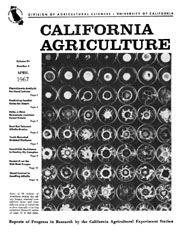


University of California
California Agriculture
|
|||
|
|||

Some of 84 isolates of Armillaria mellea, the oak root fungus, obtained from different hosts and from different areas of California to show naturally occurring variations.
April 1967
Volume 21, Number 4 News and opinionGeneral Information |
|||
|
University of California, 1301 S. 46th St., Bldg. 478 Richmond, CA
|